Most marketers grasp the basics of customer segmentation – it's the practice of sorting customers into groups based on commonalities like demographics, needs, or behaviors. Segmentation, in theory, lets us tailor messaging, pricing, even product features to resonate better with different slices of our customer base. It's the antidote to one-size-fits-all marketing.
But, there's a gap between the idea of segmentation and reaping its true benefits. Many companies either stop at surface-level segmentation or fail to effectively translate segments into bottom-line impact. This is a missed opportunity, as effective segmentation can be a force multiplier for marketing teams and an accelerant for companies.
Let me get a tad philosophical for a moment. Marketing is fundamentally about influencing behavior in ways that benefit the company. It's as true for acquisition as it is for retention and expansion. We're in the business of moving the needle. Segmentation is a powerful tool to do this, but it requires going beyond the obvious.

Segmentation That's More Than Skin Deep
Think of basic segmentation like sorting laundry by color – useful, but it doesn't tell you much about the fabric of each garment. To get deeper benefits, we need segmentation that reveals underlying needs, motivations, and pain points.
Here's where things get interesting.
Segmentation can transcend the obvious and give us tools to:
Uncover the unspoken: Don't just segment by actions taken, but by the “jobs to be done” that drove those actions. If people buy a fancy notebook, are they motivated by journaling, doodling, or project planning? Those needs demand dramatically different messaging.

Spot hidden patterns: Segmenting reveals correlations you couldn't have predicted. Customers in Kansas City disproportionately love the color blue? Now you can test messaging around “true blue values” against a control group in another market.
Get personal, without being creepy: Segmentation doesn't mean blasting impersonal emails. It means knowing that customers who first bought a running watch are statistically likely to be interested in your new hydration pack. That's tailored, not intrusive.

Segmentation vs. Buyer Personas
Let's address the elephant in the room: aren't buyer personas just another way of doing this? Kind of, but there's a crucial distinction:
| Characteristic | Buyer Personas | Customer Segments |
|---|---|---|
| Depth | Highly detailed, often fictionalized | Broader, based on real data |
| Focus | Single ideal customer | Groups sharing characteristics |
| Use Case | Understanding motivations, guiding product strategy | Targeted messaging & acquisition |
Think of it this way: personas help you understand who you're selling to, segmentation helps you figure out how to sell to them.

Segmentation Isn't a One-Time Thing
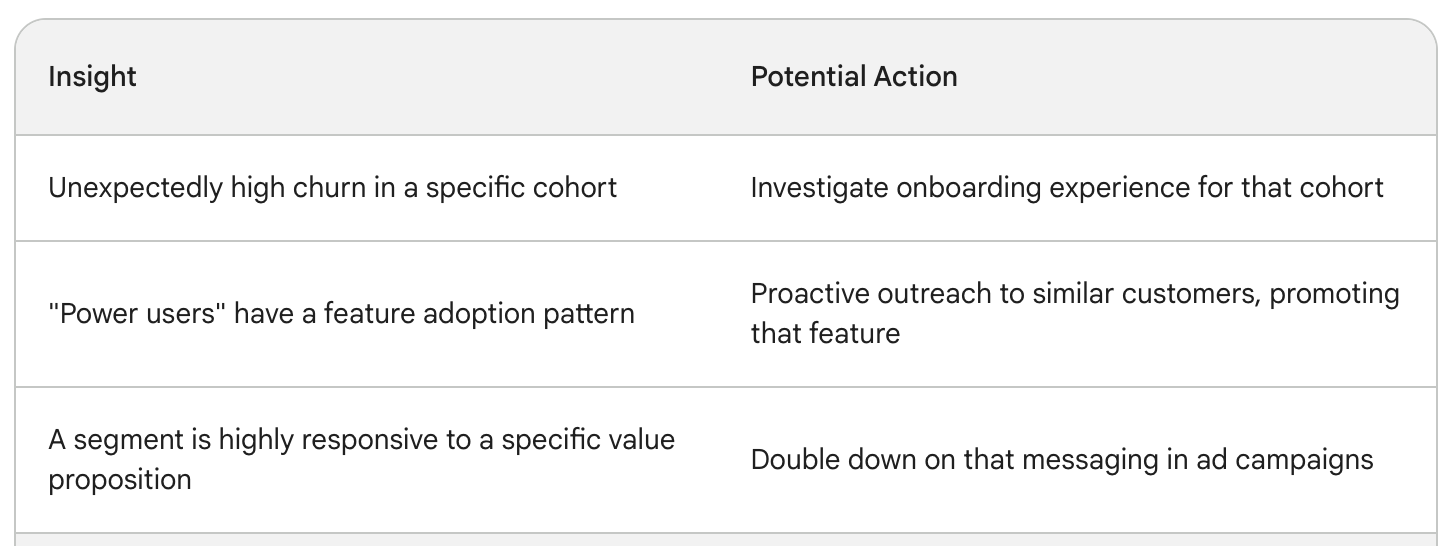
The most successful companies treat segmentation as an ongoing process, not a project with a finish line. As you gain more data and insights, you can refine and iterate. Here's where the true magic happens.
Predictive modeling
Don't just group existing customers, segment to identify prospects most likely to convert. It's like a supercharged lookalike audience. For example, your existing high-LTV customers probably share some less-obvious factors. Use those factors to target new ones.
Niche discovery
Segmentation often reveals hidden pockets of untapped potential. You might discover a small cohort of customers using your product in a way you never intended, opening up a whole new positioning angle.
The “AHA!” of churn analysis
By segmenting churned customers, you can spot patterns far beyond price sensitivity. Maybe a change in the UI alienated a specific type of user, revealing what truly matters to them.
Examples From the Trenches
Let's move away from theory, I'll share a few real examples from my work in marketing:
The SaaS Trap
Many SaaS companies segment by company size. But that missed the fact that a 10-person startup with high-growth ambitions has fundamentally different needs than a 10-person local business. Segmenting by growth trajectory transformed their messaging.
Ecommerce Underdog Victory
A smaller e-commerce player primarily operating in Bangalore, India didn't have the budget to compete on price. But they noticed a segment of customers disproportionately making late-night impulse purchases. Their new ad campaign – emphasizing fun and instant gratification – outperformed the competition.
Beyond Data
A client was obsessed with data-driven segmentation. While powerful, it missed the fact that their most loyal customers were united by a shared value system. They built a community-driven campaign around that, leading to unprecedented engagement.
Before You Start Segmenting
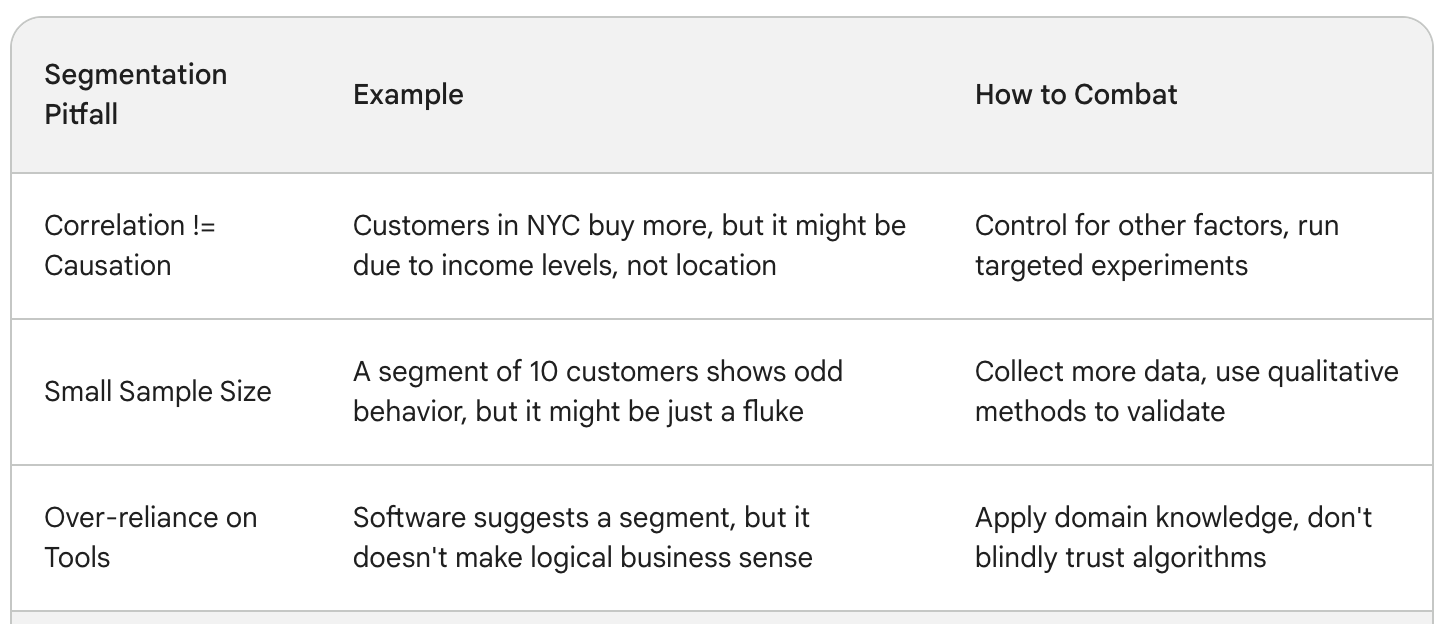
Segmentation is powerful, but it's only as good as the foundation it's built on. Keep these things in mind:
Garbage in, garbage out: If your data is messy or inaccurate, your segments will be too. Prioritize clean data collection.
The tool is not the strategy: Don't buy fancy software expecting it to do the thinking for you. Start with the key questions you want segmentation to help answer.
Tie it to action: What will you actually do differently based on this segmentation? If you don't have a plan for that, save your time.
Segmentation isn't a magic bullet, but when wielded strategically, it's one of the most powerful tools in a marketer's arsenal. The key is not just the “what” but the “why” behind it all.
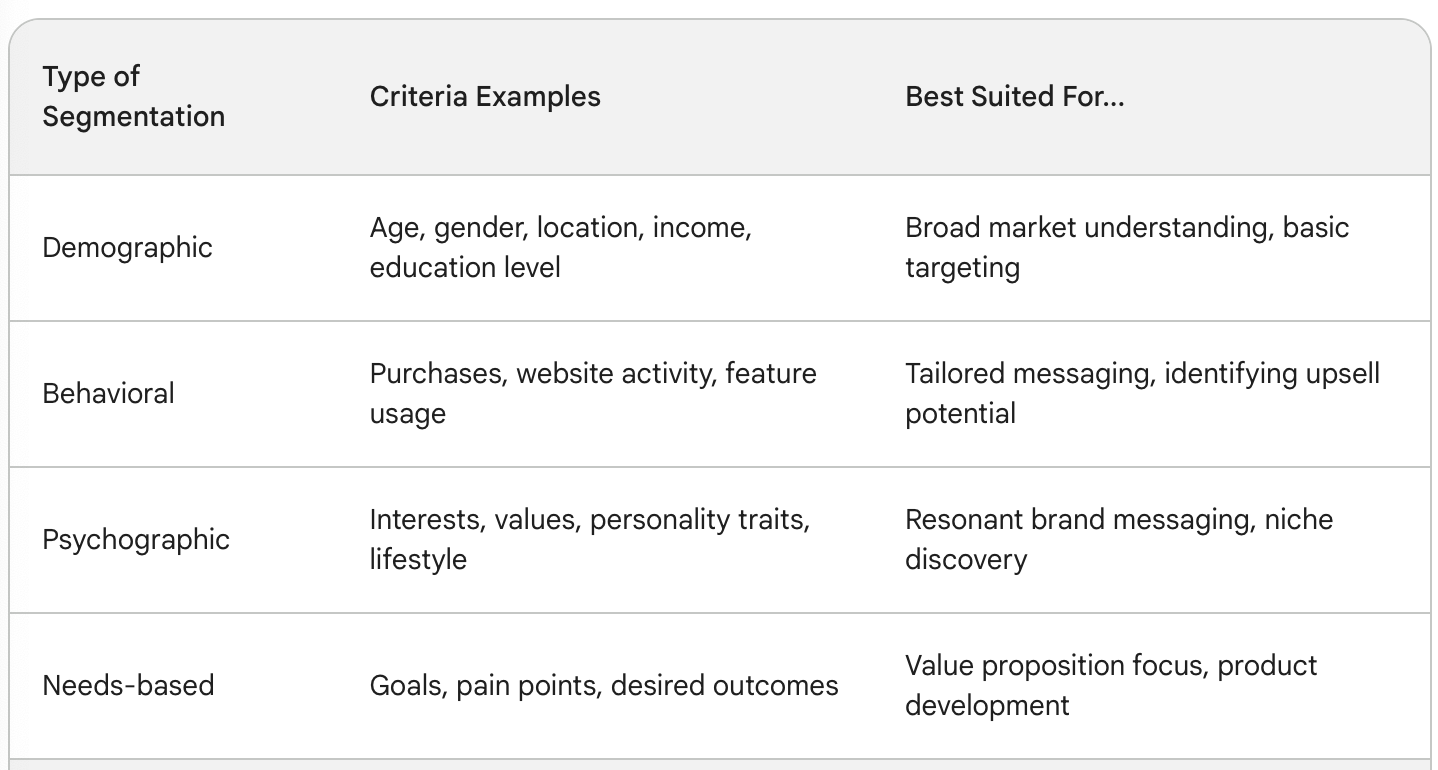
Getting Granular: Segmentation Techniques and Strategies
We've discussed the power of segmentation in the abstract – let's get down to the practicalities. Here's a breakdown of key segmentation techniques, along with the scenarios where they shine:
1. Behavioral Segmentation
- How it works: Grouping customers based on their actions within your product or website (purchases, features used, time spent, content engaged with, etc.).
- Best for:
- Tailored onboarding sequences based on how people use the product
- Identifying power users for upsell opportunities
- Pinpointing friction areas to improve conversion
- Understanding feature usage to inform product roadmap
- Example: A language learning app might segment based on lessons completed, time spent practicing, and preferred learning methods (video vs. games).
2. Psychographic Segmentation
- How it works: Grouping customers based on values, lifestyles, attitudes, and personalities. This often requires surveys or qualitative research.
- Best for:
- Crafting messaging that resonates emotionally
- Understanding what drives brand loyalty beyond the product itself
- Identifying non-traditional partnerships or collaborations
- Example: An outdoor gear retailer might segment based on whether customers view outdoor activities as a source of adrenaline, a form of mindfulness, or a social activity.
3. Needs-Based Segmentation
- How it works: Grouping customers based on the problems they’re trying to solve or the outcomes they desire. This requires deep customer understanding.
- Best for:
- Positioning your product as the solution, not just a set of features
- Uncovering underserved needs in your market
- Developing content marketing that genuinely helps your audience
- Example: A project management tool might segment based on whether customers need basic task organization, complex collaboration, or reporting for clients.
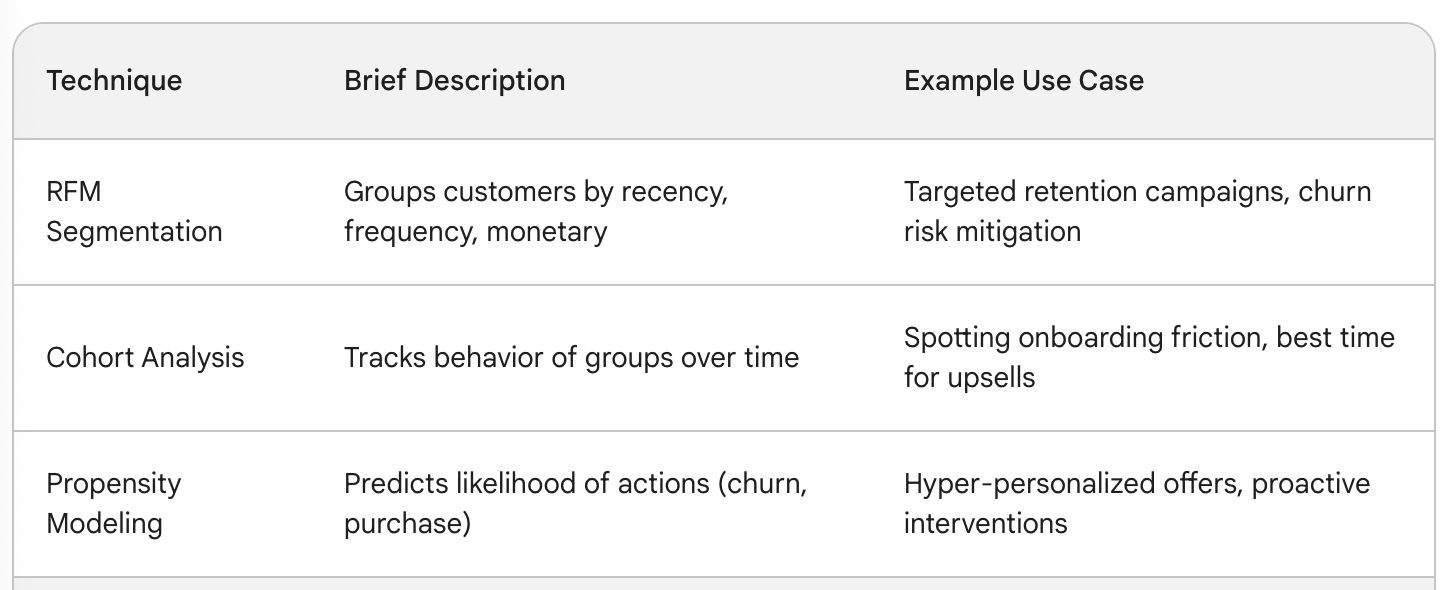
Advanced Tactics
Once you master the basics, here are some advanced techniques:
RFM Segmentation
Stands for Recency, Frequency, and Monetary Value. Prioritizes customers based on how recently & often they've purchased, and how much they spend. Excellent for targeted campaigns and churn prevention.
Cohort Analysis
Tracking groups of customers over time to see how their behavior changes. This reveals things like the true impact of onboarding or the best time in the customer lifecycle to introduce an upsell.
Propensity Modeling
Uses machine learning to predict the likelihood of customers taking specific actions (converting, churning, etc.). This allows hyper-targeted interventions.
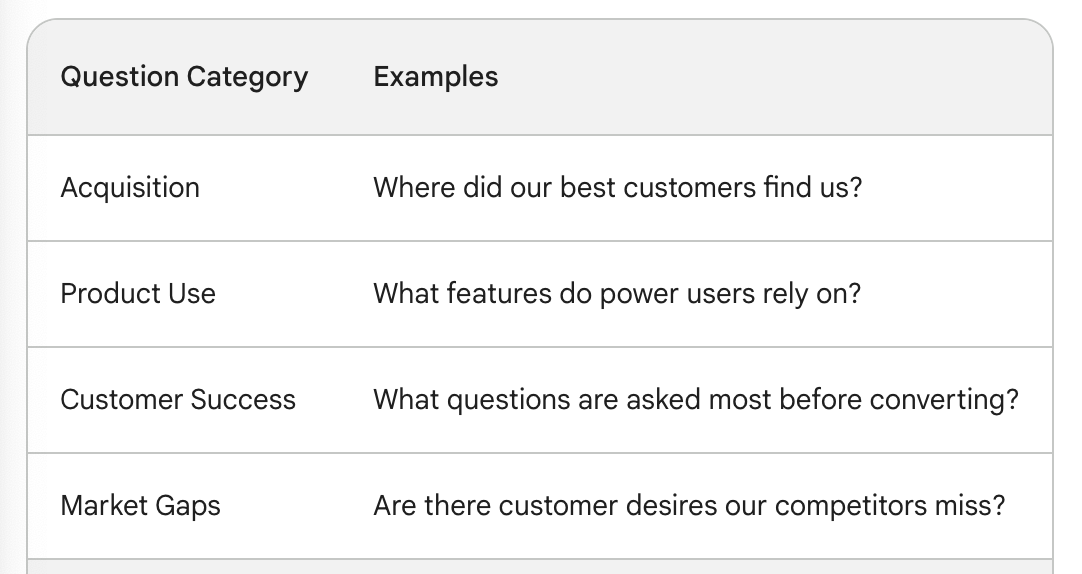
The Right Questions > The Right Software
Don't get caught up in the hype cycle of segmentation tools. Start simple. Here are a few potent questions to get those insights flowing:
- What's the most common question customers ask before buying? The way they phrase it often reveals their underlying needs.
- Where do our best customers come from? Don't just look at the acquisition channel, but the content that led them there.
- What seemingly odd correlation exists in our data? It could be time of day purchases peak, geography, or anything else. Digging into these anomalies leads to breakthroughs.
FAQ
1. My business is small, is segmentation worth the effort?
Absolutely! Even for small businesses, basic segmentation can make a big difference. Start by focusing on one or two key criteria with clear implications for your marketing. For example, if customers primarily buy from you either as gifts or for themselves, even that simple distinction can dramatically improve your email campaigns.
2. How often should we revisit our segmentation?
Ideally, segmentation should be an ongoing process. Set a cadence that works for you (quarterly, annually) to review existing segments and see if adjustments are needed. Additionally, whenever you launch a major new product or feature, it's wise to check if this warrants the creation of new segments.
3. We have lots of data, but it feels messy. Where do we even start?
Start by defining 2-3 core questions you want segmentation to help you answer. This will guide you in determining what data is most important to clean and organize. Don't get bogged down trying to make everything perfect – focus on the data that directly ties to your business objectives.
4. How do we combine quantitative and qualitative data in our segmentation?
Quantitative data (purchase behavior, website analytics) gives you the 'what'. Qualitative data (surveys, customer interviews) helps you understand the 'why' behind the actions. For example, quantitative data might show a segment with low repeat purchase rates. Qualitative research could reveal this is because they perceive your product as a luxury they only treat themselves to occasionally. This understanding then informs your messaging strategy.
5. Can we segment our email list without fancy software?
Yes! Most email marketing tools have basic segmentation capabilities built-in. You can segment based on opens, clicks, past purchases, or even just having customers self-identify by clicking a specific link in an email (e.g., "Are you primarily shopping for yourself or for gifts?").
6. What's the biggest segmentation mistake to avoid?
Don't segment just for the sake of it. If you can't articulate how a segment will be treated differently in your marketing, it's not adding value. Always tie your segments back to specific actions you'll take.
7. How do we get buy-in from other teams for our segmentation efforts?
Focus on the benefits to them! Show sales how segmentation can provide a warmer pipeline of leads. Demonstrate to customer support how it can help them prioritize issues more effectively. Frame segmentation as a tool that makes everyone's work easier, not just marketing's.
8. We tried segmentation before and didn't see great results. What could have gone wrong?
Some common pitfalls include: segments that are too broad to be actionable, not being consistent in using the segmentation, or expecting overnight miracles. Segmentation is a powerful tool, but it needs to be integrated into your overall marketing strategy and given time to have an impact.
9. Are there any ethical considerations with segmentation?
Absolutely. It's important to use segmentation responsibly. Avoid using data in a way that perpetuates biases or feels overly intrusive to customers. Be transparent about how you collect and use data, and give customers control over their preferences whenever possible.
10. What are some resources to learn even more about customer segmentation?
- Look for blogs and case studies from your email marketing or CRM provider.
- Search for industry-specific resources, as segmentation best practices can vary between fields (e.g., Ecommerce vs. SaaS).






